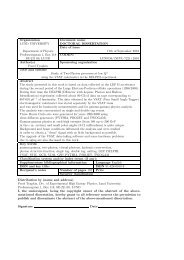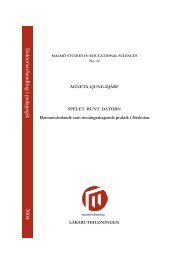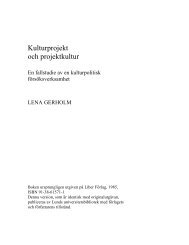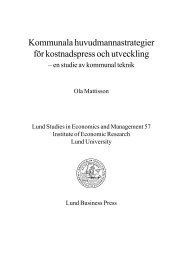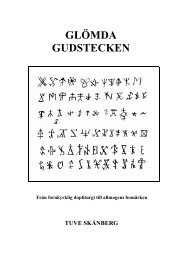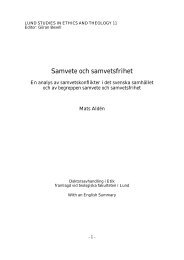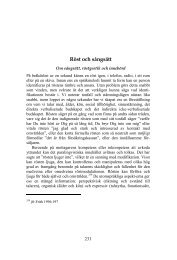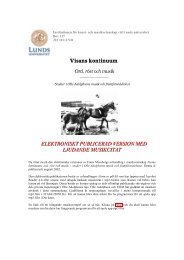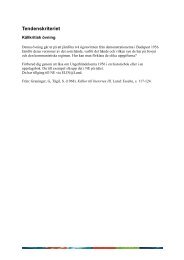Hyperpolarized Nuclei for NMR Imaging and Spectroscopy - Lunds ...
Hyperpolarized Nuclei for NMR Imaging and Spectroscopy - Lunds ...
Hyperpolarized Nuclei for NMR Imaging and Spectroscopy - Lunds ...
You also want an ePaper? Increase the reach of your titles
YUMPU automatically turns print PDFs into web optimized ePapers that Google loves.
sate <strong>for</strong> the low concentration. To obtain polarization levels where the hyperpolarized<br />
signal equals, or even outper<strong>for</strong>ms, the 1 H signal, the “brute<strong>for</strong>ce”<br />
method would require temperatures in the mK range. Large-scale<br />
production of hyperpolarized noble gases ( 3 He <strong>and</strong> 129 Xe) has been proposed<br />
using this approach (Frossati 1998); but due to the great technical challenges<br />
<strong>and</strong> costs associated with the extremely low temperatures, this method has<br />
not yet been used <strong>for</strong> in vivo applications.<br />
However, other techniques exist which sufficiently increase the polarization<br />
level of certain nuclei, including 3 He, 13 C, <strong>and</strong> 129 Xe.<br />
2.2.2 Optical pumping methods<br />
In 1960, Bouchiat et al. showed that angular momentum could be transferred<br />
from the electron spins of optically pumped Rb atoms (Kastler 1950)<br />
to the nuclear spins of 3 He by spin-exchange collisions (Bouchiat et al.<br />
1960). The method could be extended to efficiently polarize 129 Xe as well<br />
(Grover 1978). Rb atoms are pumped via the electronic transitions S1/2 – P1/2 (795.0 nm) <strong>and</strong> S1/2 – P3/2 (780.2 nm). In a magnetic field, the <strong>for</strong>mer transition<br />
can be driven by circularly polarized laser light (795 nm) to selectively<br />
pump the ground-state Rb electrons entirely to the + 1<br />
1<br />
2 (or − 2 ) state. The<br />
electronic polarization of the optically pumped Rb atoms is transferred to<br />
the nuclei of the noble gas atoms via <strong>for</strong>mation of loosely bound van der<br />
Waals molecules or via binary collisions (Figure 2). The <strong>for</strong>mer mechanism<br />
takes place at low pressure (below ∼13 mbar), whereas the latter mechanism<br />
dominates above ∼500 mbar, or at strong magnetic fields (Bifone 1999).<br />
Viewed macroscopically, the process creates a non-equilibrium polarization<br />
of the noble gas nuclei. A classic review of optical pumping methods has<br />
been given by Happer 1972.<br />
Hyperpolarization of 3 He can also be achieved by the method of metastability<br />
exchange, first reported in 1958 (Franken <strong>and</strong> Colegrove 1958). In a<br />
low-pressure 3 He gas (about 1–2 mbar), 3 S 1 metastable atoms are <strong>for</strong>med by<br />
a weak electrical discharge. By using circularly polarized light, transitions<br />
3 S1 → 3 P 0 (1083.0 nm) are induced. Due to strong hyperfine coupling, the<br />
nuclei of metastable atoms become polarized. When a polarized metastable<br />
atom collides with an unpolarized ground-state atom, a high probability <strong>for</strong><br />
exchange of metastability exists: the metastable <strong>and</strong> the ground-state atom<br />
exchange their electron shells, while the nuclear polarization remains unaffected.<br />
Thus, the collision yields a polarized ground-state atom <strong>and</strong> an nonpolarized<br />
metastable atom. The latter can once more undergo the optical<br />
8



